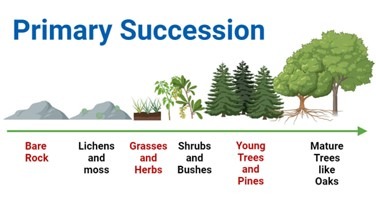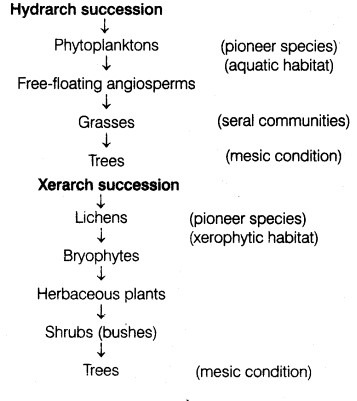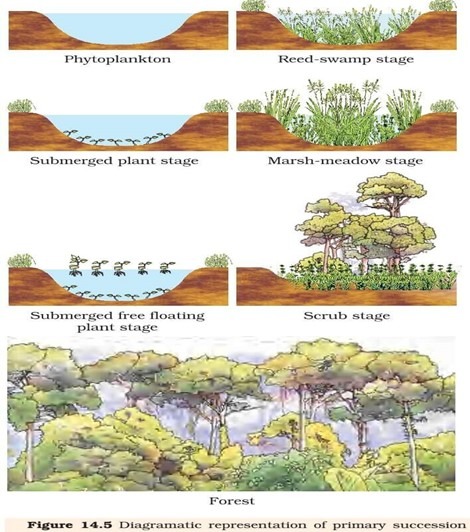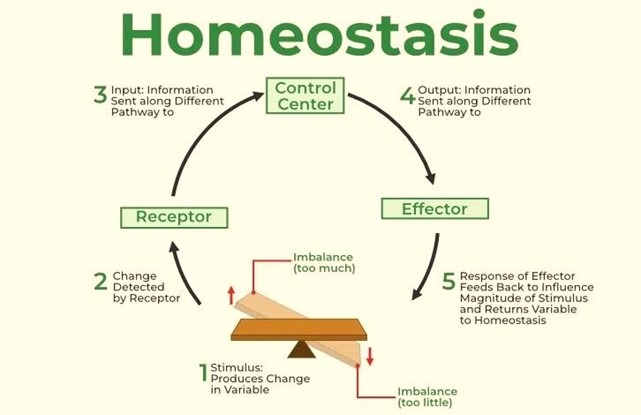Functions of an Ecosystem – Succession and Homeostasis
3. Functions of an Ecosystem – Succession and Homeostasis ………………….
Ecological Succession
Stages in Ecological Succession
Primary Succession
Secondary Succession
Autogenic and Allogenic Succession
Succession in Plants
Succession in Water
Homeostasis in Ecosystem
Homeostasis
Ecological Succession:
Stages in Ecological Succession
Primary Succession
Secondary Succession
Autogenic and Allogenic Succession
Succession in Plants
Succession in Water
Ecological succession is the natural, gradual process by which ecosystems undergo changes in their plant and animal communities over time. These changes occur in response to various environmental factors, including natural disturbances such as wildfires, hurricanes, and volcanic eruptions, as well as human-induced activities like deforestation, urbanization, and agriculture.
This dynamic process plays a crucial role in maintaining ecological balance by allowing ecosystems to recover, adapt, and develop over time. Succession can be classified into two main types: primary succession, which occurs in areas where no previous ecosystem existed (such as newly formed volcanic islands or glacial retreats), and secondary succession, which takes place in areas where an existing ecosystem has been disturbed but soil and life still remain (such as abandoned farmland or post-forest fire regions).
Over time, ecological succession leads to the establishment of stable and diverse ecosystems, fostering biodiversity and supporting the survival of various species. This ongoing transformation highlights the resilience of nature and its ability to regenerate despite challenges.
Stages in Ecological Succession:
Succession is the gradual and natural process of ecological replacement, where biological communities undergo transformation over time. This continuous process ultimately leads to the development of a stable, mature climax community, which represents the final and most balanced stage of succession. The various phases that ecosystems go through on their journey toward a climax community are referred to as successional stages or series.
Throughout the succession process, different plant and animal species establish themselves, thrive for a period, and are eventually replaced by more competitive or better-adapted species. Each temporary or transitional community that appears and then gives way to the next is known as a seral community. These communities play a critical role in shaping the environment, modifying soil conditions, enhancing biodiversity, and influencing energy flow within the ecosystem.
Key Characteristics of Ecological Succession:
- Enhanced Ecosystem Efficiency: Over time, ecosystems become more efficient in utilizing available resources, leading to improved stability and productivity.
- Nutrient Transfer from Reservoirs: Succession facilitates the movement of essential nutrients from natural reservoirs (such as soil, water, and decomposing organisms) into living communities, enhancing overall nutrient cycling.
- Increased Biodiversity: As succession progresses, a greater variety of organisms colonize the area, leading to a richer and more complex ecological network.
- Rising Food Web Complexity: The gradual accumulation of species results in more intricate food webs, improving the stability and resilience of the ecosystem.
The rate of succession is influenced by various factors, including climate, soil composition, and the availability of seed dispersal mechanisms. Notably, succession tends to occur at a faster pace in central continental areas, as these regions experience quicker seed dispersal from various seres. This rapid dispersal accelerates the establishment of new plant and animal species, facilitating ecosystem recovery and transformation at a much swifter rate.
Understanding ecological succession is essential for conservation efforts, habitat restoration, and maintaining biodiversity. By studying how ecosystems evolve and recover from disturbances, we can better support and protect the natural world.
Primary Succession:
- Primary succession is a fundamental ecological process that occurs in lifeless environments where no previous biological community existed. This type of succession typically begins in areas such as newly formed volcanic landscapes, glacial retreats, or barren rock surfaces left exposed after major disturbances. Over time, the gradual establishment of plant and animal life transforms these inhospitable landscapes into thriving ecosystems.
The Role of Pioneer Species
- The initial phase of primary succession is marked by the arrival of resilient pioneer species, such as microbes, lichens, and mosses. These organisms are specially adapted to survive in harsh, nutrient-poor conditions and play a crucial role in modifying the environment. Through their growth, metabolic activities, and eventual decomposition, they contribute to the breakdown of rocks, creating the first layers of organic material that will eventually develop into soil.
Soil Formation and Ecosystem Development
- As pioneering organisms undergo natural decay, they release organic acids and essential nutrients, gradually accumulating in pockets and crevices of the landscape. This process facilitates the formation of primitive soil, which provides a foundation for the germination of seeds and the establishment of more complex plant species, such as grasses and small shrubs.
Increasing Biodiversity and Ecological Complexity
- With the gradual improvement of soil conditions and the accumulation of organic matter, a greater variety of plants and microorganisms begin to colonize the area. This leads to a rise in both biodiversity and interspecies competition, allowing for the emergence of new ecological niches that support a wider range of organisms, including insects, fungi, and small animals.
Transition to a Mature Climax Community
- Over extended periods, continued modifications in habitat conditions drive the replacement of pioneer species by more complex and competitive organisms. These include larger shrubs, trees, and diverse animal populations that contribute to a more stable and self-sustaining ecosystem. This succession process continues for centuries or even millennia, eventually leading to the formation of a mature climax community—a stable and balanced ecosystem that can persist for long periods unless disrupted by external factors.
- Primary succession is a testament to nature’s resilience and its ability to rebuild and regenerate ecosystems from barren landscapes. Understanding this process provides valuable insights into environmental conservation, habitat restoration, and sustainable land management.
Secondary Succession:
- Secondary succession is a natural process of ecological recovery that occurs when an established climax community experiences disruption due to natural or human-induced disturbances. Unlike primary succession, which begins in lifeless areas with no initial soil, secondary succession occurs in environments where soil and organic matter are already present, leading to a significantly faster recovery process.
Causes of Secondary Succession
- Secondary succession can be triggered by a variety of environmental factors, including:
- Natural disturbances, such as wildfires, hurricanes, floods, landslides, and volcanic eruptions, which can partially or completely destroy an existing ecosystem.
- Anthropogenic (human-induced) activities, including deforestation, agriculture, overgrazing, urbanization, and pollution, which disrupt ecological balance and alter habitat conditions.
Initial Recovery Phase: Colonization of Resilient Species
- Following a disturbance, the first stage of secondary succession involves the colonization of hardy and resilient plant species. These early colonizers—mainly grasses, small shrubs, and herbaceous plants—play a crucial role in stabilizing the soil, preventing erosion, and improving nutrient content.
- During this phase, the ecosystem begins to attract faunal species, including insects, rodents, birds, and other small animals, which contribute to seed dispersal and soil aeration, further accelerating the recovery process.
Progressive Ecological Development
- As time progresses, the landscape undergoes a series of transformations:
- Taller grasses and larger shrubs establish themselves, competing for sunlight and resources.
- Trees begin to take root, slowly forming dense woodlands that provide shelter and sustenance for a diverse range of wildlife.
- The increasing complexity of the ecosystem supports a richer biodiversity, with new ecological niches emerging for various species.
Formation of a Stable Climax Community
- Over several years or decades, the disturbed landscape gradually transitions into a fully mature and stable climax community, resembling its pre-disturbance state. The restored ecosystem achieves ecological balance, with a well-structured food web, rich biodiversity, and sustainable nutrient cycling.
Key Differences Between Primary and Secondary Succession
- Soil Presence: Unlike primary succession, which starts from barren landscapes, secondary succession begins in areas where soil already exists, making the process significantly faster.
- Speed of Recovery: Secondary succession can take place over decades rather than centuries, as the foundation for growth is already present.
- Biodiversity Recovery: Secondary succession often leads to the re-establishment of plant and animal species that previously inhabited the area.
Ecological Importance of Secondary Succession
- This natural regenerative process plays a vital role in restoring degraded landscapes, helping ecosystems recover from environmental damage, and promoting long-term sustainability. By converting neglected or disturbed areas into thriving ecosystems, secondary succession contributes to habitat conservation, biodiversity preservation, and the overall health of the planet.
Autogenic Succession
Autogenic succession refers to ecological succession driven by changes initiated by the organisms within the community itself. As living organisms grow, interact, and decompose, they gradually modify their environment, leading to conditions that support new species and facilitate succession.
- For example, in a forest ecosystem, plant roots stabilize soil, while decomposing organic matter enriches the soil with nutrients, promoting the growth of more complex plant life.
- Similarly, in aquatic environments, algal growth influences oxygen and nutrient levels, affecting the succession of other aquatic species.
Allogenic Succession
Allogenic succession, on the other hand, is influenced by external environmental factors rather than internal biological processes. These changes are driven by natural forces such as:
- Climate variations (temperature fluctuations, rainfall, drought)
- Soil erosion and sediment deposition
- Geological activities (volcanic eruptions, glacial movements)
- Human interventions (deforestation, pollution, urbanization)
Unlike autogenic succession, where organisms actively modify their habitat, allogenic succession occurs when external forces alter the physical conditions of an ecosystem, triggering shifts in species composition.
Succession in Plants: Transformations in Different Habitats
Succession in plant communities is primarily influenced by environmental conditions, with different types of succession occurring in specific settings.
Xerarch Succession: From Dry Environments to Balanced Ecosystems
- Xerarch succession begins in arid, dry environments, such as bare rocks, deserts, and sand dunes.
- The first colonizers, such as lichens and mosses, break down rock surfaces, facilitating soil formation.
- Gradually, hardy grasses and shrubs establish themselves, followed by larger plants and trees.
- Over time, these dry habitats transform into mesophytic ecosystems with moderate moisture levels, supporting a wider variety of plant and animal life.
Hydrarch Succession: From Water to Land
- Hydrarch succession occurs in aquatic environments, such as ponds, lakes, and marshes.
- Floating plants and submerged hydrophytes (such as phytoplankton and rooted aquatic plants) colonize the water body.
- Over time, emergent plants, sedges, and grasses establish themselves, reducing water levels through transpiration and sediment accumulation.
- Eventually, the ecosystem transitions from an aquatic environment to terrestrial land, forming a mesic climax community with balanced moisture conditions.
Despite occurring in different settings, both xerarch and hydrarch succession follow a common trajectory, evolving towards an ecosystem with optimal moisture levels and greater biodiversity.
Succession in Water: The Gradual Transition from Aquatic to Terrestrial Ecosystems
Aquatic succession demonstrates how water bodies undergo natural transformations over time, gradually evolving into terrestrial landscapes.
Primary Succession in Water: A Stepwise Process
1. Pioneer Stage – Microscopic phytoplankton (algae and cyanobacteria) serve as the first colonizers, producing oxygen and organic matter.
2. Floating Angiosperms – Species like duckweed and water hyacinths emerge, contributing to nutrient cycling.
3. Rooted Hydrophytes – Plants such as lotus and water lilies take root, stabilizing sediments.
4. Sedges and Grasses – As organic matter accumulates, marsh plants such as reeds and sedges establish themselves, trapping sediments and reducing water depth.
5. Shrubs and Trees – Over time, the landscape dries further, allowing woody plants and trees to grow, eventually leading to a forest climax ecosystem.
Through this gradual process, the once fully aquatic environment is transformed into land, showcasing the dynamic interplay between aquatic and terrestrial succession.
HOMEOSTASIS IN ECOSYSTEMS
Homeostasis in Ecosystems: Maintaining Ecological Balance
Homeostasis in ecology refers to the ability of ecosystems to regulate themselves, maintaining a stable and balanced state despite external changes. Ecosystems achieve this balance through self-regulating mechanisms, such as nutrient cycling, predator-prey dynamics, and species interactions.
Examples of Ecosystem Homeostasis:
- In a pond ecosystem, populations of zooplankton and phytoplankton fluctuate in a cyclical manner—when phytoplankton increase, zooplankton populations rise due to increased food availability, but as zooplankton consume phytoplankton, their numbers decline, allowing phytoplankton to rebound.
- In forests, predators help control herbivore populations, preventing overgrazing and promoting plant regeneration.
- Coral reefs maintain balance by regulating algal growth through herbivorous fish populations, ensuring reef stability.
The Role of Negative Feedback Mechanisms
- Ecosystems rely on negative feedback loops to regulate population sizes and resource availability.
- However, homeostasis is not always perfect—excessive disturbances such as pollution, habitat destruction, and climate change can disrupt these self-regulating mechanisms, leading to ecological imbalances.
Homeostasis in Living Organisms: Adapting to Environmental Changes
Just as ecosystems regulate balance, homeostasis in organisms refers to the ability to maintain a stable internal environment despite external fluctuations.
Examples of Homeostasis in Organisms:
- Temperature Regulation: Humans sweat to cool down when it’s hot and shiver to generate heat when it’s cold.
- Blood Sugar Regulation: The body maintains glucose levels through insulin and glucagon hormones.
- Water Balance: The kidneys regulate water retention and excretion to prevent dehydration.
This self-regulating ability is vital for survival, allowing organisms to adapt, function efficiently, and thrive in diverse environments.
Ecological succession, whether autogenic or allogenic, xerarch or hydrarch, plays a crucial role in shaping ecosystems. Similarly, the principles of homeostasis ensure stability in both natural environments and living organisms. By understanding these processes, we gain valuable insights into ecosystem resilience, biodiversity conservation, and sustainable resource management—key elements in preserving the health of our planet.
Living organisms have developed various survival strategies to cope with environmental fluctuations. These strategies include regulation, conformity, migration, and suspension, each of which allows species to thrive under different ecological conditions.
Regulate: Maintaining Stability in Changing Environments
Regulation is a process by which organisms actively maintain homeostasis—a stable internal environment—despite external environmental changes. This can be achieved through physiological and behavioural mechanisms that help them function optimally in varying climates.
- Organisms employ physiological adaptations such as sweating in humans and panting in dogs to regulate body temperature.
- Behavioural adaptations, such as seeking shade, burrowing underground, or basking in the sun, help conserve or dissipate heat as needed.
- Thermoregulation and osmoregulation are key survival mechanisms in birds, mammals, and some lower species, allowing them to regulate body temperature and maintain osmotic balance.
- Mammals excel in extreme climates due to their ability to sustain a constant body temperature, allowing them to survive and reproduce in harsh environments ranging from scorching deserts to freezing tundras.
- Unlike animals, plants lack active thermoregulation mechanisms, limiting their geographical range and making them more susceptible to temperature fluctuations.
Through these mechanisms, regulators can inhabit a diverse range of ecosystems, from the Arctic to tropical rainforests.
Conform: Adjusting to Environmental Changes
Unlike regulators, many organisms adjust their internal conditions in response to external environmental fluctuations, a process known as conformity.
- Instead of actively maintaining a stable internal environment, conformers allow their body temperature, metabolic rate, and other physiological factors to change based on their surroundings.
- Ectothermic animals such as reptiles, amphibians, and fish rely on external temperatures to regulate their body functions.
- This strategy is energy-efficient but limits their ability to survive in extreme climates.
- Small animals, like shrews and hummingbirds, struggle to regulate heat efficiently, making them less common in colder regions where thermoregulation requires high energy expenditure.
By conforming to their surroundings, these organisms conserve energy but are often restricted to environments where conditions remain within a tolerable range.
Migrate: Moving to Favourable Conditions
Migration is a temporary relocation strategy used by organisms to escape unfavourable environmental conditions. Many species travel long distances in search of better climate, food availability, or breeding grounds.
- Migratory birds undertake seasonal journeys to avoid harsh winters and find food-rich environments.
- An example of this behavior is seen in birds that flock to Keoladeo National Park in India during the winter months, escaping the freezing temperatures of their native habitats.
- Terrestrial animals such as wildebeests in Africa migrate across the Serengeti in search of fresh grazing lands.
- Marine species, including whales and sea turtles, travel vast distances across oceans for breeding and feeding purposes.
Migration allows species to enhance survival, ensure reproductive success, and maintain population stability by avoiding inhospitable conditions.
Suspend: Surviving Harsh Conditions Through Dormancy
For organisms that cannot regulate or migrate, suspension is a survival mechanism that allows them to withstand extreme environmental conditions by entering a dormant state.
- Microorganisms such as bacteria, fungi, and simple plants produce resilient spores, enabling them to survive drought, extreme heat, or freezing temperatures.
- These spores remain dormant until conditions improve, at which point they germinate and resume growth.
- Animals also exhibit suspension strategies:
- Hibernation in bears and hedgehogs helps them survive winter by slowing down metabolism and conserving energy.
- Aestivation in amphibians and reptiles allows them to survive extreme heat by burrowing underground.
- Diapause in insects is a period of suspended development that helps them endure adverse conditions.
By suspending metabolic activity, these organisms increase their chances of survival in challenging environments.
Regulation, conformity, migration, and suspension are critical survival strategies that allow organisms to adapt to diverse and changing environments. Whether an organism actively regulates its internal state, conforms to its surroundings, migrates to better habitats, or enters dormancy, these mechanisms play a vital role in maintaining biodiversity and ecosystem balance. Understanding these strategies provides insight into how life persists and evolves in the face of environmental challenges.





